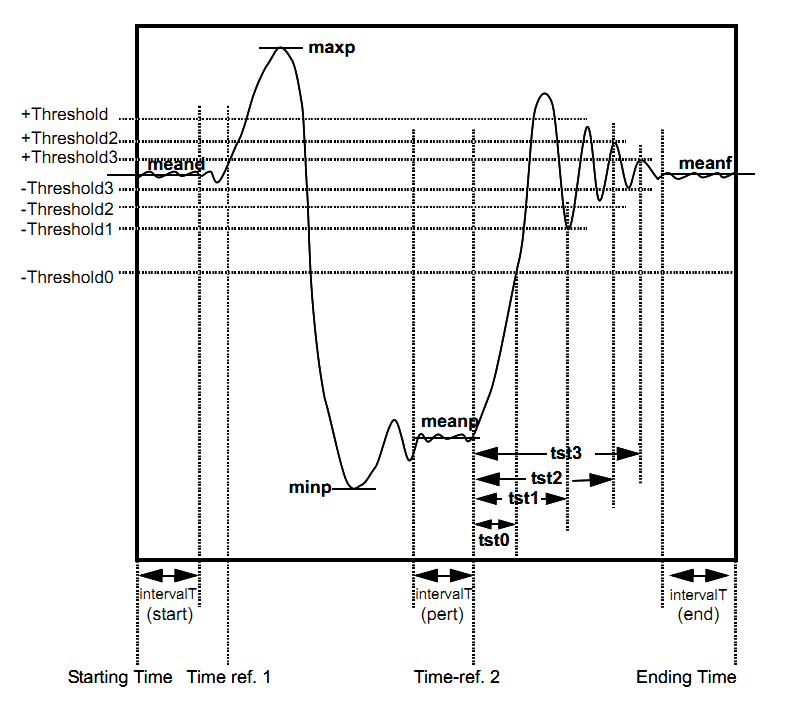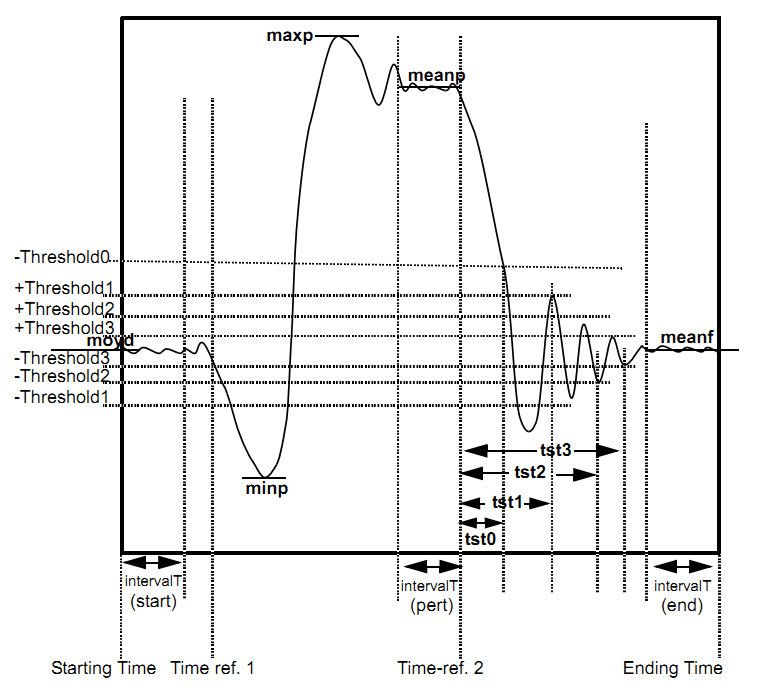Documentation Home Page ◇ HYPERSIM Home Page
Pour la documentation en FRANÇAIS, utilisez l'outil de traduction de votre navigateur Chrome, Edge ou Safari. Voir un exemple.
Advanced | SIDYN2F
DYNAMIC RESPONSE – [SIDYN2F]
Computes the dynamic response of a control signal following a disturbance....
CATEGORY
Advanced
DESCRIPTION
The function computes the dynamic response of a control system after a disturbance. This function allows computing mean, minimum and maximum values and stabilization times.
Note: The order of operations of this function is not as important as for other functions, but it is useful to know.
| 1 | Course of the signal from reference Ref_Time1 to reference Ref_Time2 to find the minimum and maximum of the disturbance. |
| 2 | Calculation of the mean on the Interval (moyd) first milliseconds, of the mean on the interval (moyf) last milliseconds and of the mean on the Interval (moyp) milliseconds preceding reference Ref_Time2. These values are returned as the moyd, moyf and moyp results. |
| 3 | Calculation of time taken to reach the different threshold values for the stabilization times. |
RESULT VARIABLES AND PARAMETERS
| maxp | Maximum value of the input signal between first and second reference times (Ref_Time1, Ref_Time2). |
| minp | Minimum value of the input signal between first and second reference times (Ref_Time1, Ref_Time2). |
| moyd | Mean value before the disturbance. The mean value is computed on the first milliseconds of the analysis, i.e. before the average time start (Avg_Time_Start). |
| moyf | Mean value after the disturbance. The mean value is computed on the last milliseconds of the analysis, i.e. after the average time end (Avg_Time_End). |
| moyp | Mean value during the disturbance. The mean value is computed between the average perturbation time (Avg_Time_Pert) and the reference time 2 (Ref_Time2). |
| tst0 | Zeroth stabilization time. Time in milliseconds [ms] relative to the second reference time (Ref_Time2) when the 0 threshold value (Threshold0) is reached after reference time 2 (Ref_Time2). |
| tst1 | First stabilization time. Time in milliseconds [ms] relative to the second reference time (Ref_Time2) when the first threshold value (Threshold1) is reached, minus reference time 2 (Ref_Time2). |
| tst2 | Second stabilization time. Time in milliseconds [ms] relative to the second reference time (Ref_Time2) when the second threshold value (Threshold2) is reached, minus reference time 2 (Ref_Time2). |
| tst3 | Third stabilization time. Time in milliseconds [ms] relative to the second reference time (Ref_Time2) when the third threshold value (Threshold3) is reached, minus reference time 2 (Ref_Time2). |
| Signal | input signal to analyze. |
| Threshold0 | Threshold used to compute the zero stabilization time. This percentage [%] of the mean before disturbance is added to or subtracted from the mean to latter determine the threshold to reach in order to evaluate the response time. The percentage is subtracted if the mean before disturbance is higher than the mean during the disturbance. When the opposite is true, the mean is added. |
| Threshold1 | Threshold used to compute the first stabilization time. This percentage [%] of the mean before disturbance is added to and then subtracted from the mean before disturbance to yield two threshold values, one on each side of the mean before disturbance. The stabilization time is computed using these two threshold values. |
| Threshold2 | Threshold used to compute the second stabilization time. This percentage [%] of the mean before disturbance is added to and then subtracted from the mean before disturbance to yield 2 threshold values, one on each side of the mean before disturbance. The stabilization time is computed using these two threshold values. |
| Threshold3 | Threshold used to compute the third stabilization time. This percentage [%] of the mean before disturbance is added to and then subtracted from the mean before disturbance to yield 2 threshold values, one on each side of the mean before disturbance. The stabilization time is computed using these two threshold values |
| Ref_Time1 | Time in milliseconds [ms] serving as reference for the beginning of the disturbance. This time is relative to time 0 of the acquisition buffer. |
| Ref_Time2 | Time in milliseconds [ms] serving as reference for the end of the disturbance. This time is relative to time 0 of the acquisition buffer. |
| Avg_Time_Start | Time interval in milliseconds [ms], at the beginning of the analysis limits, on which is computed the mean value before the disturbance (moyd). |
| Avg_Time_End | Time interval in milliseconds [ms], at the end of the analysis limits, on which is computed the mean value after the disturbance (moyf) |
| Avg_Time_Pert | Time interval in milliseconds [ms] ending at reference time (Ref_time2), on which is computed the mean value during the disturbance (moyp). |
| Begin_time | Time at which the analysis of a signal must start. This time is expressed in milliseconds [ms]. This value must be greater than 0 and lower than the size of the acquisition buffer. The default value is 0. |
| End_time | Time at which the analysis of a signal must end. This time is expressed in milliseconds [ms]. The value of this time must be larger than the specified begin_time and smaller than the duration of the test. Use the “HUGE” value to specify the end of the test. The default value is HUGE. |
| Factor | Multiplying factor for the results generated by the function. The default value of the multiplying factor is 1.0 and has no effect on the results. The multiplying factor only applies to the following results: tst0, tst1, tst2 and tst3. The other results are not modified. |
SYNTAX
[maxp, minp, moyd, moyf_1, moyp, tst0, tst1, tst2, tst3] = sidyn2f(input, threshold0, threshold1, threshold2, threshold3, time1, time2, time_start, time_end, time_pert, 0, HUGE, 1)
CHARACTERISTICS
Data type support
Double Floating point
EXAMPLE
The following figure shows the results for a signal whose disturbance voltage is lower than initial voltage.
The following figure shows the results for a signal whose disturbance voltage exceeds the initial voltage.
OPAL-RT TECHNOLOGIES, Inc. | 1751, rue Richardson, bureau 1060 | Montréal, Québec Canada H3K 1G6 | opal-rt.com | +1 514-935-2323
Follow OPAL-RT: LinkedIn | Facebook | YouTube | X/Twitter

